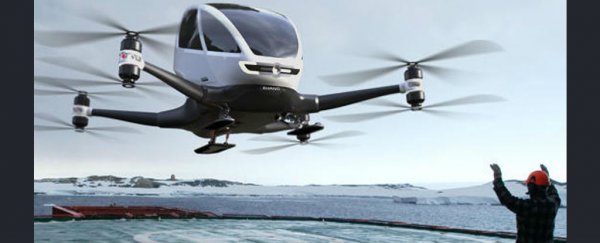Officials from Dubai's state transport authority have announced that they aim to have hover-taxis up and running by July this year, with passengers able to get around at an altitude of 300 metres (1,000 feet), and at speeds of up to 100 km/h (60 mph).
The vehicle they're banking on, called the EHang 184, actually merges two of the biggest advancements in transport in recent years - hovering and self-driving technology.
The idea is that passengers will program their destination at the start of the ride, and the hover-taxi will get them there - no driver required.
The EHang 184, built by Chinese drone manufacturer EHang, has been in development since 2013, and was on display this week at the World Government Summit 2017 in Dubai.
"The autonomous aerial vehicle exhibited at the World Government Summit is not just a model," director general of the Dubai Road and Transport Authority, Mattar al-Tayer, told reporters.
"We have already experimented [with] the vehicle in a flight in [the] Dubai sky."
Al-Tayer also mentioned at the event that the Dubai Transport Authority was "making every effort to start the operation of the autonomous aerial vehicle in July 2017", in response to current traffic congestion issues.
Of course, we've seen many flying and hover car concepts come and go over the past few years, breaking our hearts every time their big promises of changing the face of transport forever fail to bear out, so we have to remain skeptical until this thing is actually in operation.
But having also recently signed on with US-based company, Hyperloop One, to figure out if constructing a near-supersonic rail link from Dubai to the Emirati capital Abu Dhabi is feasible, the local government does appear to be fully committed to trying new things when it comes to transport.
The state has recently announced plans to ensure that quarter of its transport is self-driving by 2030, and also signed on to purchase 200 self-driving taxis from Tesla at the World Government Summit this week.
According to an AFP report, the EHang 184 is a small quadcopter drone powered by eight propellers. It can travel on a programmed course at 100 km/h (60 mph) at an altitude of 300 metres (1,000 feet), and can carry a single passenger at a time.
The vehicle is about 1.5 metres tall (5 feet), weighs approximately 200 kg (440 pounds), and can recharge in 2 hours.
In its capacity as a Dubai taxi, it will make trips to a set list of destinations up to 30 minutes away - roughly 16 km, or 10 miles - from the hover-taxi rank.
"Passengers don't need to learn how to fly it, they don't need get to a pilot's license," EHang co-founder Derrick Xiong told Aaron Tilley at Forbes last year.
"They just need to press a button and then it vertically takes off, flies from point A to point B, and lands."
As Tilley reports, the Ehang 184 operates with a fail-safe system that will automatically land the vehicle if it senses that any component is damaged or not functioning properly.
"EHang will also have a command centre that employs people to make sure everything is safe - sort of like an air traffic controller at an airport," Xiong told him.
"The command centre will monitor every 184 in the air 24/7, and the company plans integrate with existing air traffic controller operations."
This means that it will be up to the discretion of safety advisors if weather conditions on any given day are safe enough for flight.
One concern Tilley pointed out is, at the time of reporting in June 2016, the 184 wasn't equipped with the same kind of sense-and-avoid technology that self-driving cars on the road in the US have.
He speculates that this could pose a safety risk, but hopefully that's something the Dubai authorities have investigated.
As with all things tech, we'll have to see the great hover-taxi up and running before we believe it. But we're excited all the same to see if it gets off the ground, so to speak.
Maybe 2017 will be the year that we finally reach 'the future', and get the flying cars we were always promised.
Here's some footage of the EHang 184 from CES in June 2016:

